| Penn Common is a large area of open land that is
bounded by the A449 Wolverhampton to Stourbridge Road in the west,
Wodehouse and Gospel End Road to the south, the town of Sedgley to
the east and Upper Penn to the north. The common was a poorly
drained area, part of which was occupied by a number of small farms
that were situated on the better agricultural land. |
| It was a popular place to go for a day out and many
Wolverhampton and Black Country folk would come here for a walk or a
picnic and visit one of the many pubs that were on the Common. Tea
could be purchased from some of the cottages and a game of bowls was
available on the green at the "Turf Tavern", which sold the products
of the Burton Brewery Company Limited. |
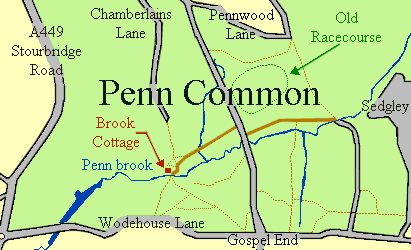
The location of the common.
|
|

The Turf Tavern and the duck pond. |
The "Turf Tavern" was by the duck pond and kept by
Daisy Collins. It closed in about 1916 and has since been converted
into a private house. Some of the other pubs included the "Malt
Shovel", the "Yew Tree", "Holly Cottage Club", "Rollasons Club" in
the "Lloyd Roberts Buildings", and the "Barley Mow", which is still
there today. Teas were sold in the "Turf Tavern", "Ivy Cottage",
"Pear Tree Farm", "Spring Cottage" and "Rose Cottage". |
| There was an old racecourse on the centre of the
common which has been replaced by the golf course that is still
there today. Race meetings were held over two days. The entrance fee
was usually half a guinea, payable before the meeting at the "Fox
and Goose" public house. In 1822 the stewards were James Shaw
Hellier of the Wodehouse and Anthony Tamlyn. In 1824 they were
Edward Tandy of Mount Farm and Benjamin Quinton. In 1826 it was the
turn of Mr. Neale and Mr. Wright. The clerk of the course was John
Hancox. |

Turf Tavern and the duck pond as they are
today. |
| Some of the races were called matches and others
were for plates. Matches were held between two or three horses,
often with heats and a final run on the same day. The race was
usually run over a distance of about two miles. A plate meant that
there was a guaranteed cash prize, some of which were for "Gallaway"
ponies, which originated in Scotland. Races were also held for
horses from the Himley and Enville troop of Yeomanry Cavalry, with
each horses having to attend at least three field days. At the
course there were booths for the sale of liquor and an amusement
fair. The races continued for many years. |
|
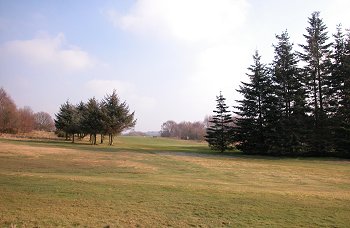
Penn Common golf course |
The golf course was built after the formation of the
South Staffordshire Golf Club, which held its first meeting on
October 24th, 1892. In December of that year the
freeholders met at the Wynn Endowed School at Springhill and
appointed a committee to discuss the plans to play golf on the
common. On December 30th the general committee of the
golf club met at the Barley Mow pub on the common and agreed to
spend £50 on draining the land. |
| The change of use from common land to golf course
was agreed by the commoners and the Duke of Sutherland who was Lord
of the Manor. Lord Dartmouth was appointed as the club’s first
president and William Lloyd Roberts, tenant of the Barley Mow became
the clubs first steward. The first season began in 1893 and £97 was
spent on drainage and a 9-hole course was built. A joint committee
of commoners and club members was set up and the club paid £10 and
then £20 annually to be equally divided between improvements on the
common and a recreation ground at Bradmore. Ladies golf started in
1894 and the decision was taken to build a clubhouse next to the
Barley Mow. The course was extended to 18 holes in 1898 and the
clubhouse was extended in 1899. In 1908 the South Staffordshire Golf
Club moved to Tettenhall and Penn Golf Club was formed to run the
course. |
| The north eastern corner of the common was known as
the seven cornfields and nearby on the slopes of Colton Hills was
Penn brickworks. Bricks were made from the local clay that
outcropped in the area and were very hard wearing. Crushed lime was
added to the clay and this led to a lot of blistering on the bricks.
The clay was dug from the surface and eventually a deep hole formed
which over a period of time filled with water. |

Penn Common from an old postcard. |
| If a quantity of bricks was ordered, the customer’s
name would be stamped on top of each brick. After closure, the
buildings remained empty for sometime and were demolished in the mid
1930s. "Beacon View" cottage, which was owned by Len Collins, was
built from Penn bricks and the Collins name was on each brick. The
cottage was built around 1890 by Len's grandad who was a milkman. |
|
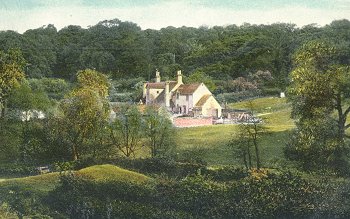
Nash's Farm which overlooks Penn Brook. |
Penn brook, originally called Lloyd brook, flows
westwards across the common from its source on Colton Hills. It was
one of the boundaries of the land that was granted to Lady Wulfruna
in 994. When the brook leaves the common it becomes the River Wom
after which Wombourne is named. It then flows through Wombourne and
joins Smestow brook just north of Smestow. The area around the brook
was heavily wooded and contains some of the best agricultural land
in the area. |
| Many small cottages were built by the brook and
some of the occupants farmed the land and benefited from the
excellent natural water supply from local springs. At the eastern
end of the brook is "Glen Harrow" and next door are the three "Ivy
Cottages" known as "Bug’s hole". The nickname says a lot about the
conditions at the time. They were later called "Primrose cottages".
To the west is "Holly Cottage" which was owned by James Lakin in the
1880s. He used to ride in the Penn Common races. By 1905 "Holly
Cottage" was a club with Mr. Roberts as steward. Next door was
"Brook House" owned by John Hickman and rented to Thomas Bradley. By
1900 there was a bakery at the house run by Mr. Hayes. In 1909 he
was succeeded by Mr. Edward Morgan who sold milk. |
| James Lakin also owned "Rose Cottages". In about
1900, coalminer Mr. Wakefield and his wife moved into one of the
cottages. Mr. Wakefield worked at Baggeridge colliery which came
into full production in 1912 and greatly effected the local economy,
with many miners living on the common. Two 19th
century cottages lie on the western side of Sedgley Road and
Charlie Stow grew up in one of them. He joined Penn Golf Club and
became a famous golfer winning the English Golf Union Brabazon
Trophy in 1948 and 1953. |
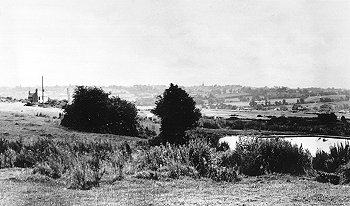
Old Penn Common. Courtesy of Lawson
Cartwright.
The scene looks very different today, much of the land has been
drained and trees grow everywhere. |
| One of the oldest cottages is "Baggeridge View"
which was built in the 18th century. Nearby is "Spring
Cottage". It was owned by John Hickman and from 1908 the Beeston
family lived there and sold tea to the public. From 1917 the Cross
family occupied the property and lived there for over 40 years. To
the west is "Peartree farm" which was named after the "Tettenhall
Dick" pear trees that were once a common site in the area. |
|
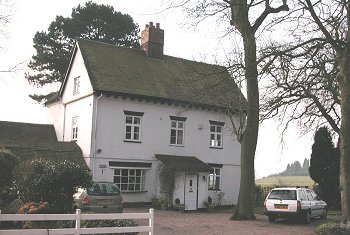
Penn Moor farmhouse as it is today. |
On the western side of the common were two of the
larger farms, "Lloyd Farm" and "Wodehouse Farm". To the north was
"Penn Moor Farm" which in the 19th century was the home
of the Jenks family. They worked land on some of the nearby farms
including "Bearnett Farm", "Orton Grange Farm" and "Lloyd Farm".
John Jenks rented the farm from the Lloyd estate, which was sold in
1901 by Harriet Bradney Shaw Hellier of the Wodehouse. "Penn Moor"
was sold for £3,700 to H. Pitt and H. Hughes. |
| The farmhouse consisted of a large sitting room,
hall, kitchen, dairy, scullery and a bake oven. There were four
bedrooms on the first floor and four attic rooms at the top. Outside
there was a large walled-yard and a water pump. After the sale the
house was occupied by Charles Henry Webb who farmed the land. In
1927 the estate was sold to Francis J.J. Gibbons of Penn Hall and a
year later, the house but not the land, was sold to Herbert
Beresford Clode on condition that it was first offered to the Penn
Hall Estate on resale. |
| Close to "Penn Moor Farm" is Chamberlains Lane,
which extends southwards into the heart of the common. It is named
after the Chamberlain family who were yeoman farmers on the common
during the 17th and 18th centuries. "Pennwood
Farm" was owned by the Williams family and called "Williams farm".
It went up to the "Park Hall Hotel" and was worked by the family who
lived in the farmhouse. "Mount Farm" was occupied and worked by the
Goad family. Barrell Price and his sons who lived in cottages
opposite the almshouses worked on the farm. |
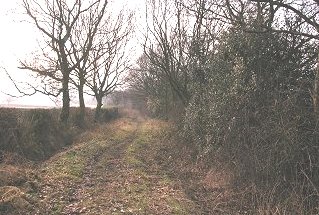
The footpath on the south of Chamberlains Lane
as it is today. |
|
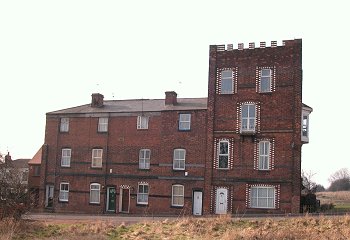
The old brewery and the Lloyd Roberts
buildings. |
Penn Brewery was situated by Sedgley Road and built
by John Millard of Netherby Hall, Gospel End. On the site was a good
supply of spring water and nearby were fields of malting barley and
cereal crops. The brewery had its own malthouse and seemingly was in
an ideal situation for beer making. Unfortunately it opened at a
time when much larger and more mechanised breweries were appearing
in the area. The brewery had a succession of managers, but couldn’t
compete with the large breweries and ceased trading around 1900. |
| The building was purchased by James Lakin who took
down the chimney, removed the pitched roof and gave the building its
present ornamental look.
For many years gypsies came to the common and set up camp on
the fields by the side of Sedgley Road. Gypsy Smith died on the
common and is buried at St. Bart’s church. It is said that her
caravan and its contents were burned on the common after her
death.
The common looks very different today. It was well known for
its course grass, sedge and gorse bushes. The common was swathed
in yellow when the gorse was in flower. Today much of the land
has been drained and trees are everywhere. The golf club
occupies the central area of the common and the once basic
cottages have been converted into luxury homes. |
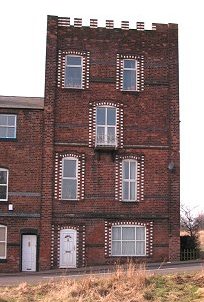
Another view of the brewery. |
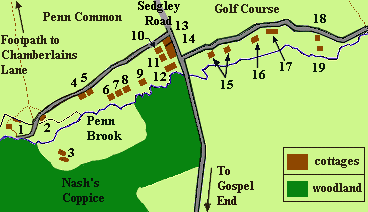 |
Many of the farm cottages on
the common were situated close to Penn Brook, which flows through
some good agricultural land. The map shows the cottages and some of
the woodland that was an important feature along the southern
boundary of the common. |
|
The cottages alongside
Penn Brook |
| 1 |
Brook Cottage. Elsie's home. |
|
11 |
Alton Cottages |
| 2 |
Baggeridge Cottage |
|
12 |
Two 19th century cottages |
| 3 |
Nash's Cottage |
|
13 |
The old brewery |
| 4 |
Peartree Farm |
|
14 |
Lloyd Roberts Buildings |
| 5 |
The Malt Shovel Inn |
|
15 |
Rose Cottages |
| 6 |
Spring Cottage |
|
16 |
Walnut Cottage |
| 7 |
A 20th century cottage |
|
17 |
Brook House and Holly Cottage |
| 8 |
A 20th century cottage |
|
18 |
Glen Harrow |
| 9 |
Baggeridge View Cottage |
|
19 |
3 Ivy Cottages (Bug's Hole) |
| 10 |
Ivy Cottage |
|
|
|
References
1).
Angus Dunphy, Penn.
2).
Angus Dunphy, Penn to Paper.
3).
Angus Dunphy, Penn and Ink.

|
|

|
Return to
the beginning |
|
Proceed to
The Early Years |
|